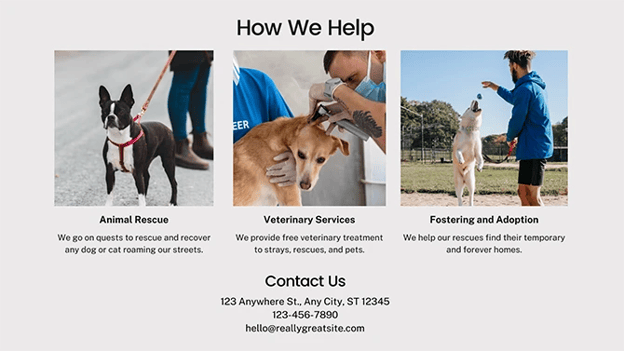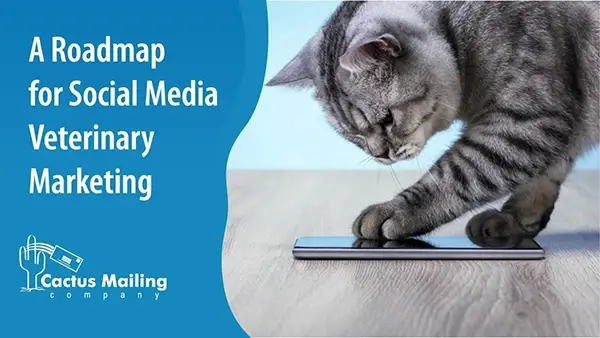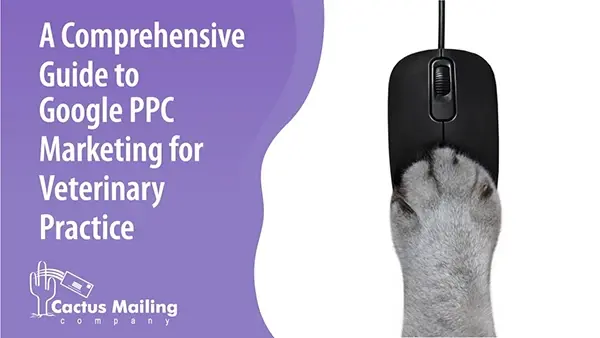We Are Here to Help!
What to Expect from Us:
No Pressure, Just Service!
Get no obligation pricing details and strategies that will work for your business.
and 7 more to get ahead of your competition!
A strong online presence is indispensable for any business. Your website design and features can make or break your digital marketing efforts. A well-crafted website for veterinary marketing is a powerful tool where all of your marketing efforts converge to create a seamless user experience. Using your website to help a new client find credible and compassionate veterinary care is one of the most important internet marketing tools.
From boosting a vet clinic’s visibility through search engine results and local SEO practices to serving as a platform for content marketing, a carefully designed website extends a veterinary clinic's marketing efforts. We're here to make sure that your website is set up to help you connect with pet parents seeking veterinary services.

Things to Consider in Website Design
A well-organized website for a veterinary practice is essential for effective veterinary marketing. Here are some specific features and best practices that are crucial for a vet practice's website:
User Experience (UX)
When planning a website for veterinary marketing, think about your users as you build it. Implement a user-friendly design and navigation that prioritizes user experience. You can achieve this by having a clear structure, a mobile-responsive site, and straightforward navigation to important pages. Potential clients should be able to quickly find relevant information on your website such as services offered, contact details, and educational resources.
- Menu Structure: Craft a straightforward, clear, intuitive site menu, categorizing various sections like ‘Services’, ‘Contact Us’, and ‘About Us’ for easy access.
- Breadcrumb Navigation: This helps users easily trace back their steps on the website or explore other site sections, contributing to a more user-friendly experience. An example of this is: Home > Services > Consultation
- Responsive Website: Ensure your website automatically adjusts and displays correctly on multiple devices, particularly mobile phones and tablets.
Content and Visuals
Fill your website with relevant, informative content about veterinary services, pet care education, and regularly updated blogs or news. Be consistent with your branding through colors, fonts, and imagery.
- Services Information: Detail the types of veterinary services that are offered at your clinic.
- Educational Resources: Include helpful articles or links that provide potential clients with valuable information on pet care.
- Blog Section: Consider maintaining a blog to share service updates, news, and additional educational content.
- Social Media Integration: Have links or buttons that direct to the clinic's social media marketing platforms or options to share content on users’ social media.[CTA: Social Media]
- Meet the Team Page: Here, you can include team member profiles and intros to the veterinary staff, their expertise, and professional experience. You can also include photos of the facilities, staff, and happy pets.

- Branding: Maintain a consistent theme that aligns with your veterinary clinic’s brand style and values.
- Imagery and Fonts: Use attractive images and easy-to-read fonts that resonate with the compassionate and professional care you provide at your clinic.
Check out this article from iMatrix about 19 Best Veterinary Website Designs For 2023 to see how UX, content, and visuals work together.
SEO and Optimization
Implement essential SEO practices, including keyword integration, clean URLs, and XML sitemaps, while optimizing the website’s speed through image and multimedia adjustments.
- Keywords: Incorporate relevant veterinary SEO keywords within your website's content, titles, and headings to enhance visibility on search engines.
- Sitemap and URLs: Maintain a clean URL structure, website flow, and XML sitemap to improve your website’s SEO friendliness. See also our article on Veterinary Local SEO.
Security and Accessibility
Prioritize your website's security to protect client information and enhance your website’s trustworthiness. Also, ensure the website is accessible to all users, including those with disabilities, to create an inclusive online environment.
- SSL Certificates: Employed to encrypt data, safeguarding client information while they're on your website.
- Trust Badges: Display relevant trust badges or certifications to reassure visitors of the website’s credibility and professionalism.
- Privacy Policy and Terms of Service Pages: Legal pages to build trust and comply with legal requirements.
- Alt Tags: Utilize alt tags for images to improve accessibility for visually impaired users.
- Color Contrast: Ensure that text and background colors contrast sufficiently for easy readability and accessibility.
Analytics and Maintenance
One crucial aspect of a successful website for veterinary marketing is the proper implementation of analytics and maintenance. Integrate tools like Google My Business for ongoing site performance monitoring and user behavior insights. Analytics allows you to make data-driven decisions and optimize your veterinary marketing strategy accordingly. Monitoring the performance of your website is essential to ensure its effectiveness and relevance.
With tools like Google Analytics, you can track various Google ads metrics such as traffic, bounce rate, and conversion rates. This data provides valuable insights into how users interact with your site, enabling you to identify areas for improvement. Make analytics and maintenance a top priority for your website and watch your veterinary marketing efforts thrive.
- Content Updates: Regularly refresh the website content, ensuring it remains accurate and up-to-date. You also maintain the interest and engagement of your audience when you regularly refresh the content on your website. Updates enhance the user experience and demonstrate your commitment to providing the latest and most relevant information for pet owners.
- Functionality: Consistently ensure that the website operates seamlessly, making necessary adjustments and updates as trends and technologies evolve. Ensure your website is user-friendly and easily accessible across various devices and browsers.
Website Features You MUST Implement
A veterinary clinic's website should incorporate various features to enhance user experience, improve accessibility, and boost online visibility. Here are some essential features:
Must-Have #1: Informative Homepage
The homepage should provide a brief yet comprehensive overview of the clinic's services, emphasizing its commitment to pet care and well-being. Inbound marketing techniques can be employed here to ensure that potential clients are not only informed but also engaged. High-quality images and videos should showcase the clinic's facilities, professional staff, and happy pets under their care.
Photos can include shots of veterinarians interacting with animals, well-maintained examination rooms, and cheerful pets, effectively showing the quality of care provided. This visual content not only informs visitors but also evokes an emotional connection with anyone who sees the photos, which is a powerful element of effective marketing services. Your webpage can also leave a lasting impression on visitors by mixing helpful facts about your service and how your clinic is different from other veterinary practices.
Must-Have #2: Service Pages
Service pages are important for a veterinary website's marketing strategy. They help potential clients find detailed information about the available veterinary services and treatments. Every service page should include in-depth descriptions of the treatments and procedures offered, like vaccinations, dental care, and flea and tick prevention.
For instance, you can put on the "Pet Treatments" page, all of the treatments that you provide, ensuring that potential clients understand the kind of care their pets will receive. Specialized services, such as surgeries, can include information on every step, from the initial consultation to post-operative care, making a new client feel comfortable and informed about the process.
It's also helpful to provide cost information for common procedures, payment methods, and pet insurance options, helping pet owners plan financially for their pets' care.

Must-Have #3: Contact and Location Information
Be sure to clearly display the clinic's contact information on your site. Make sure to include multiple contact options such as phone numbers, email addresses, and a contact form for online inquiries for good measure. At the bottom of your website, you may also add your social media accounts or other messaging applications where a pet owner can get in touch with you.
To help them get to you, embed an interactive map with the clinic's location pinned, making it easy for visitors to find directions or view the clinic's proximity to landmarks and major roads.
Must-Have #4: Online Appointment Scheduling
Implement an intuitive and user-friendly appointment booking system that allows pet owners to select their preferred date and time for appointments, streamlining the entire booking process. Once an appointment is booked, your marketing effort extends to the realm of email marketing. Once a potential customer inquires via email or a blank form, you can opt to send an automatic confirmation email with the appointment details and any necessary instructions they need to know.
This not only confirms the appointment but also serves as an opportunity to engage further with your clients. You can include helpful tips on what to do before an appointment, information about your clinic's services, or even links to specific pet care blog posts. If you have an efficient inquiry and booking process, that can ease your clients through their customer journey.
Must-Have #5: Client Testimonials and Reviews
Highlighting positive testimonials and reviews from your existing clients is a powerful way to build trust and credibility in your veterinary business. You can prominently feature these on the homepage or dedicate a separate testimonials page to showcase the experiences of pet owners who have entrusted their beloved animals to your care.
With their consent, you can include the client's name and a photo of their pet alongside their online review, adding a personal touch to the recommendations. Furthermore, consider sharing detailed success stories or case studies that vividly demonstrate your clinic's expertise and compassionate care.
These stories can include before-and-after photos and in-depth descriptions of the treatment provided, showcasing the remarkable transformations and positive outcomes achieved through your veterinary services. Such veterinary business success stories not only inspire confidence in your clinic but also provide valuable insights to potential clients seeking exceptional care for their pets.
Read our article that discusses Google Business and Google PPC for Veterinary Services.
.webp?width=670&height=377&name=Veterinary%20templates%20(1).webp)
Must-Have #6: Educational Blog
Maintain a blog section and consistently publish new blog posts to keep the content fresh and relevant. Include engaging visuals and infographics to make complex information easier to understand.
It is best to cover a wide range of pet-related topics from general pet care tips to informative articles. Some examples include:
- Pet Care Tips: Create comprehensive guides on various aspects of pet care. Offer practical tips and advice to help pet owners maintain their pets' health and happiness. Your blog can talk about pet nutrition, grooming, exercise, and dental care.
- Senior Pet Care: Offer guidance on caring for older pets or how to manage older pet issues like arthritis, cognitive decline, and age-related health concerns.
- Pet Travel Tips: Provide information on traveling with pets, including preparation for trips and airline regulations.
- Pet Health Articles: Continually update this section with informative articles on a wide range of pet health topics. Cover issues like common illnesses, recognizing signs of illness, first aid and emergency care, and the importance of preventive care.
- Pet Behavior Resources: Offer guidance on understanding and addressing common behavioral issues in pets. Include tips on training, socialization, and dealing with anxiety or aggression.
Must-Have #7: FAQ Section
As a veterinary practice, we understand that pet owners often have numerous concerns and questions regarding their furry friends' health, appointments, billing, and emergency care. To help address these common concerns, we have compiled a comprehensive list of frequently asked questions (FAQs) and provided clear and concise answers for your convenience.
Compile a comprehensive list of frequently asked questions that address common concerns pet owners may have about their pets' health, appointments, billing, and emergency care.
Provide clear and concise answers to each question, ensuring that clients can easily find the information they need without having to search extensively.
In Townsquare Interactive's article about Veterinary Marketing Ideas, having a website is #1. However, providing only the bare minimum of a website might not cut it in today's competitive landscape. So we've come up with other suggestions to help you have an advantage.
7 Tools to Get Ahead of Your Competition
In addition to the essential features mentioned earlier, consider dedicating a section designed to empower pet owners with valuable information and tools to ensure the well-being of their beloved companions. This will not only position your veterinarian marketing website as a valuable resource for potential customers but also empower them to take an active role in their pets' health.
Tool #1: Pet Symptom Checker
Provide an interactive tool that allows pet owners to input symptoms their pets are experiencing. The tool can offer initial insights into potential health issues and recommend whether a veterinary visit is necessary.
Tool #2: Vaccination and Preventive Care Calendar
Veterinary clinics can offer a customizable vaccination and preventive care calendar. Pet owners can input their pet's information and receive timely reminders for vaccinations, flea and tick treatments, dental check-ups, and more.
Alternatively, have a downloadable file that they can fill out and keep a physical copy. Make sure to include your clinic's details on the file!
Tool #3: Weight Management and Nutrition Tools
Provide tools for a pet parent to track their pets' weight and body condition. Include guidelines on maintaining a healthy weight and offer resources and exercise plans. Also share insights into pet nutrition, including the importance of balanced diets, portion control, and dietary restrictions for pets with special health needs.
Tool #4: Community Forums or Pet Owner Groups
Consider creating a community forum or a space where pet owners can connect, share experiences, and seek advice from fellow pet lovers. This fosters a sense of community and reinforces your clinic's role as a trusted resource. Your community will not be limited to local pet owners and current clients because this marketing idea can help you reach other pet lovers all over the world!
Tool #5: Pet Care Resources for Kids
Consider adding a section aimed at educating young pet lovers about responsible pet ownership. Include kid-friendly articles, activities, and games that teach children about pet care, safety, and compassion.
Tool #6: Pet Health Glossary
Include a glossary of common veterinary terms and medical jargon. This can help pet owners better understand diagnoses and treatment options.
Tool #7: Emergency Contact Information
In the unfortunate event of a pet emergency, every second counts, and having the necessary numbers readily available can make all the difference in providing prompt and efficient care.
Compile a comprehensive list of emergency contact numbers for local animal hospitals or emergency veterinary clinics. Include a brief overview of the services available such as critical care, surgery, or 24-hour monitoring.

Conclusion
Investing in a well-designed veterinary website that incorporates these features demonstrates your commitment to excellence and compassionate care. It not only enhances your online marketing and digital marketing strategy but also provides valuable resources to pet owners in need of timely veterinary care.
By following these guidelines, you can create a reliable, user-friendly, and optimized website that effectively connects with potential clients and supports your clinic's online marketing goals. In times of stress and uncertainty, your website will act as an information hub that will provide pet owners with peace of mind and accurate information on how to care for pets.
The more touch points your potential clients can make contact with you, the better credibility your veterinary clinic will have. Your website is only one of the numerous ways you can connect to pet owners. Make sure that you implement everything that we mentioned so you can have the best chance to set yourself apart from your competition.🌐
Our postcards have helped various businesses get leads, boost awareness, and grow revenue. Let us help you create a pet services postcard design that can achieve your marketing goals!

 Cactus Mail Team: Feb 02, 2024
Cactus Mail Team: Feb 02, 2024



